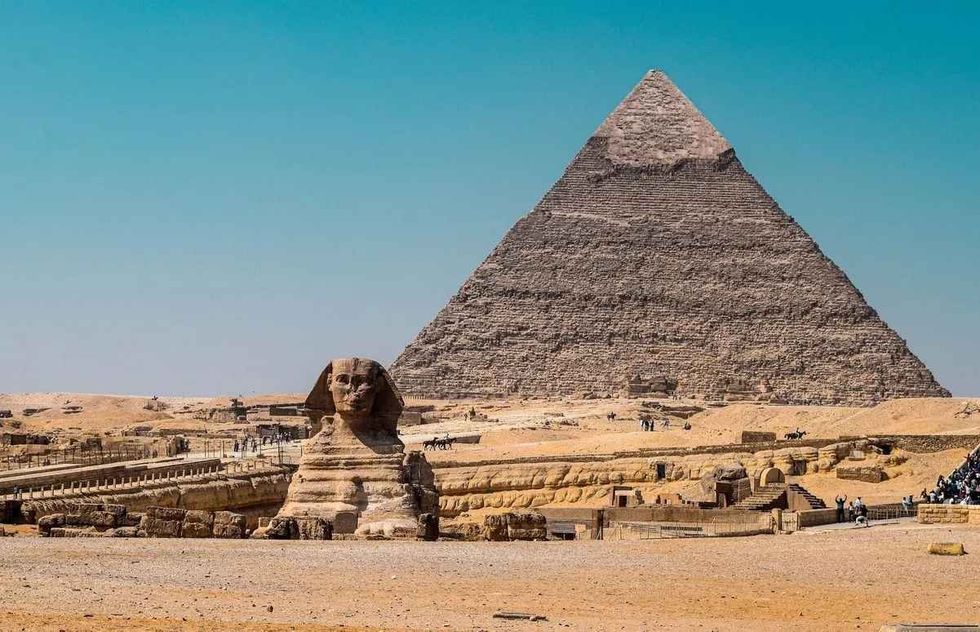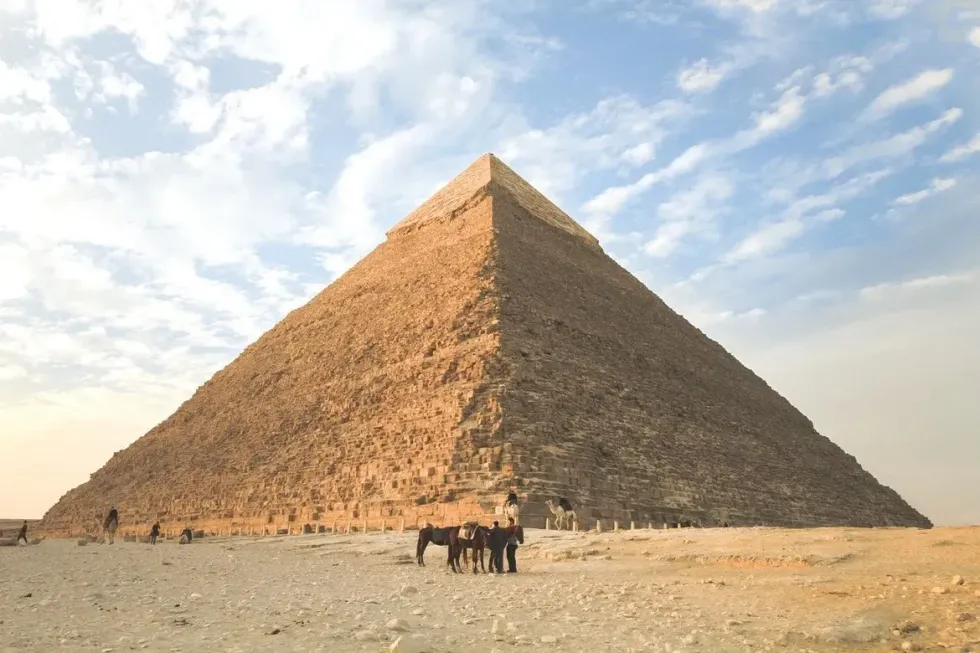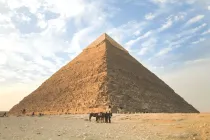Biggest Pyramids In Egypt: How And When Were They Made And More

Ancient Egyptian pyramids are magnificent man-made structures that have survived weathering and the passage of time and are still there for us to see, marvel, and explore!
The great pyramids of Egypt were built as burial grounds for Egyptian pharaohs. The burial chamber of the pharaohs was often deep inside the pyramids, filled with all kinds of valuable treasure which the ancient Egyptians believed were needed by the Pharaohs to succeed in their afterlife.
There are around 138 pyramids in Egypt and some of them are huge. The earlier pyramids were called step pyramids because they had large ledges which made them look like steps from afar.
Archaeologists believe that these steps were constructed as stairways to help the Pharaoh climb up to reach the Sun God. The later pyramids had more sloping smoother edges which represented a mound that emerged at the inception of time, where the Sun God stood and created the other Gods and Goddesses.
How these large pyramids were built is still an enigma to the archaeologists that they have been striving to solve this mystery for years.
It is however believed that slaves were instructed to cut up large blocks of limestone and then move them up the pyramid using ramps and this is how the great pyramid structure was completed, one block at a time.
Because the construction of pyramids was tedious and time-taking, Pharaohs would start constructing their pyramids as soon as they became rulers.
If you find this read fascinating, be sure to check out our other articles on Sobek Egyptian god and Aztec pyramids facts!
The Most Notable Pyramids Of Egypt
The pyramids of Egypt are considered the greatest landmarks of the ancient world. They are ancient masonry structures of Egypt built for the Egyptian kings and queens, that have become a reputable identity of the country. These dynasty pyramids can give an insight into the time period.
Pyramids stand as a reminder of the Egyptian belief that glorified death with the idea that it was the beginning of a brand new journey to another world.
The major pyramids to visit in Egypt include the Great Pyramid of Giza, Pyramid of Khufu, Pyramid of Khafre, Pyramid of Menkaure, Bent Pyramid, Pyramid of Djoser, the Red pyramid, and the Luxor Pyramid.
The Giza Pyramids on the Giza plateau in Greater Cairo, Egypt includes the Great Pyramid of Giza (considered the main pyramid of wide interest), the Pyramid of Menkaure, and the Pyramid of Khafre along with the other associated complexes and the Great Sphinx.
An amazing aspect of the Great Pyramid of Giza is the architecture which along with the antechamber, Big Void, and King's chamber, has relieving chambers to ensure the pyramid doesn't collapse on the King's Chamber.
These are five chambers placed above the roof of the King's Chamber.
The oldest and northernmost pyramid, the Pyramid of Khufu, was listed as one of the seven wonders of the ancient world. It was built for the Egyptian pharaoh Khufu, the second king of the fourth dynasty.
Khufu's pyramid has underground tunnels and the burial chamber is located at the pyramid's core which can be accessed by a tight internal passageway.
Pyramid of Khafre was built for Khafre, the fourth of the eight kings of the fourth dynasty and it is well known for having the Great Sphinx of Giza located just outside of it.
The pyramid of Menkaure is the southernmost and the last pyramid of the Giza necropolis. It was built for Menkaure, the fifth king of the fourth dynasty. The construction materials of the pyramid of Menkaure were red granite at the bottom portion and limestone towards the top.
Step Pyramid of Djoser is the oldest pyramid in ancient Egypt; it was built as a tomb of pharaoh Djoser. This is situated in the northwest city of Memphis and was built in the 27th century B.C and is made of limestone.
The design is one of six mastabas stacked on top of the other, each one smaller than the previous. There are 14 doors built into three walls.
Other great features include a great trench surrounding the complex and the ornate stone pillars in the roofed colonnade corridor. The South court is a large area separating the pyramid from the South tomb.
The pyramid of Sneferu or the Southern shining pyramid (Bent Pyramid) is situated at the heart of Dahshur. The base rises from the desert surface at an angle of 54-degree but the angle to the top section becomes 43 degrees.
As a result, the pyramid looks bent at one side and hence the name. It is regarded as the first real smooth-sided pyramid in Egypt. Unlike other pyramids, the exterior polished limestone of the Bent Pyramid has been preserved well.
Famous as the North Pyramid, the Red pyramid is the third largest pyramid. It is found in Dahshur and has the largest base of all in Egypt.
This is the second pyramid built by Pharaoh Snefru. The Red pyramid name is due to the use of red limestone that is used for construction.
Snefru was known to be the first person to use the east-west alignment of the Egyptian temples to match the sun. The remains of a mortuary temple are found in the east of the pyramid.
The pyramid is 344 ft (104.85 m) high and contains three chambers. It has earned quite fame not only because of its color but also because it is one of the largest pyramids to exist.
The Meidum Pyramid was designed for Huni, the last pharaoh of the third dynasty, and was originally a step pyramid. The outer layer was made of sand instead of stone which led to the collapse of the pyramid.
Natural Regions Of Egypt and the Egyptian Climate
Egypt is an extremely wondrous country and one of the striking features of the country is its climate. Egypt is a part of the desert belt of north Africa and hence there exist low rainfall levels along with extreme variations in daily temperature levels.
Summer extends from May through September approximately and is characterized by very high temperatures throughout the country's inland areas.
Egypt experiences several sandstorms, dust storms, accompanied by reduced levels of humidity and a sudden surge of temperature. These frequently occurring storms are named Khamsins.
Winds blowing at gale force along with sudden extreme temperatures are commonly experienced. The winter here is mild and cool. Humidity decreases as we move from the north to the south of the country, that is, it is higher along the Mediterranean stretch.
The natural regions of Egypt are fascinating to note as the landscape includes varied geography from north to south.
The Sinai Peninsula is a wedge-shaped land section situated between the Mediterranean Sea (north) and the Gulf of Suez (south). Rugged mountains feature the southern part of the Sinai Peninsula including Mount Catherine which is the tallest mountain of Egypt. Lake Bardawil, a large salt lagoon, is also located here.
Nile River Valley And Delta is a lifeline to Egyptian civilization, the north-flowing River Nile goes through the Nile valley and ends in a large delta on Egypt's Mediterranean coast. Perennial irrigation has been made possible due to the construction of the Aswan High Dam, which allows crops to be grown all through the year.
Lake Nasser, one of the world's largest man-made lakes and also a major tourist attraction, is located just behind this dam.
The Nile delta stretches from Cairo, the capital city of Egypt to the shores of the Mediterranean Sea, and the delta coastline extends from Port Said to Alexandria. Rosetta and Damietta, major branches of the Nile flow through the delta.
The landscape of the Western Desert is characterized by an area of stony tracts that lie between sandy ridges. The massive stretch of the desert's arid land extends from River Nile's western banks to the Egypt-Libya borders.
Al-Jilf al-Kabir plateau in the southeast is the highest elevation of the Western Desert.
The plateau has a gradual slope on the northeastward side forming two depressions and ending in the uninhabitable Qattara Depression, which is virtually impassable. The most populated oasis in the region, the Oases of Siwa, lie to the west of the Qattara Depression.
The Eastern Desert covers almost one-fourth of Egypt's total area of the country stretching from north to south of the River Nile delta to Egypt's shared borders with Sudan.
The sandy desert rises abruptly as a gently rolling highland from the eastern banks of the Nile river valley eventually giving way to the arid and volcanic mountains of the Red Sea Hills that run from north to the south.
These rugged mountain chains are often interrupted by several wadis (valleys). Mount Shaib al-Banat is the tallest peak of this region.
Despite the inhospitable nature of the Eastern desert due to its lack of water resources and uneven terrain, it is rich in natural resources such as oil, gold, phosphate, uranium, and manganese.
Materials Used For The Construction Of Pyramids
The pyramids were built with baked mud bricks, limestone, granite, gypsum (mortar), and basalt. Blocks of limestone were quarried at Giza while granite was obtained most likely from the upriver at Aswan. Basalt came from the Fayoum Depression and alabaster from Luxor.
Since iron tools were unavailable at that time, the workers and laborers used copper and other stone cutting tools to shape and carve out the pyramid building blocks at the quarries. Other tools used by the Egyptians for the pyramid's construction include copper pickaxes, chisels, dolerite, granite hammers, chisels, and other tools and of stone.
It is unlikely that the workers used wheels to transport the building blocks as most pyramid fields constituted of sand and gravel. It's presumed that the stone blocks were moved to the quarry site with the help of levers.
Some also believe that workers dragged the blocks with wooden sleds tied with ropes.
Others say that they attached the sleds to the blocks and used wooden rollers to roll them along the sand till they reached the construction site. Barges were used for long-distance transportation and canals were built to get the barges nearer to the site.

Great Pyramid Of Giza
Also known as the Pyramid of Khufu or the Pyramids of Cheops, the Great Pyramid of Giza is considered one of the largest pyramids in the Giza pyramid necropolis. It is also one of the oldest pyramids constructed during a span of 10-20 years.
It is believed to have started during 2550 B.C. The Great Pyramid is believed to be the most colossal single building ever made on the planet.
It is a masterpiece of appreciable engineering capabilities and technical skills, combined with fine motor and artistic skills. It has an orientation that follows the four cardinal points of the compass.
The pyramid core is made from blocks of yellowish limestone, the inner passage and outer casing are made of finer light-colored limestone and the interior burial chamber has been constructed with large granite blocks. The pyramid originally had a smooth covering of white limestone that reflected sunlight in the day and moonlight at night.
The entrance to the Great Pyramid is 59 ft (17.98 m) above ground level on the northern side. A sloping corridor enters in the masonry of the pyramid's interior chambers, penetrating deeper on which the structure rests and ends in an unfinished chamber.
From the sloping corridor, arises an ascending passage that leads to the Queen's chamber and to a huge slanting gallery.
The Queen's empty sarcophagus was found at the bottom of a deep stone-filled shaft along with furniture and valuable jewelry. A long narrow passage from the upper end of the gallery gives access to the King's chamber which is entirely lined by granite.
In order to shield the ceiling of the chamber, there are five compartments just above the king's chamber divided by huge horizontal granite slabs. There are two narrow shafts that run obliquely from the king's chamber to the exterior of the pyramid.
The complex also includes mortuary temples, mastaba tombs for the nobility and other members of the royal family. The Great Sphinx carved out of limestone with a facial feature of a man and the body of a recumbent lion, lies to the south of the Great Pyramid.
In 1925, a pit tomb was discovered that contained the transferred burial equipment of Queen Hetepheres, Khufu's mother was discovered.
Surrounding the three pyramids are extensive fields of funerary structures with flat tops, arranged in a grid-like pattern, which are called the mastabas. Mastabas are used for the burial of relatives and officials of the king.
Pyramids As Sources Of Tourist Attraction
Egypt has the most number of tourist attractions for people visiting Africa, attracting millions of tourists every year.
The pyramids are Egypt's most popular tourist attraction, constituting a large part of Egypt's income. They are the long-standing reminders of the ancient world, the old kingdom of the world-famous civilization.
While the great Pyramids of Giza and the Sphinx are obviously the biggest crowd-pullers, there are other smaller pyramids to check out, you can go in and experience it yourself. The gigantic remains of the ancient world speak of Egypt's rich history and are a remarkable experience for history buffs and travel enthusiasts.
Here at Kidadl, we have carefully created lots of interesting family-friendly facts for everyone to enjoy! If you liked our suggestions for the biggest pyramids in Egypt then why not take a look at ancient Egypt history for kids or ancient Egypt games for kids.
We Want Your Photos!
More for You
Bachelor of Arts specializing in English, Master of Arts specializing in English

Rajnandini RoychoudhuryBachelor of Arts specializing in English, Master of Arts specializing in English
With a Master of Arts in English, Rajnandini has pursued her passion for the arts and has become an experienced content writer. She has worked with companies such as Writer's Zone and has had her writing skills recognized by publications such as The Telegraph. Rajnandini is also trilingual and enjoys various hobbies such as music, movies, travel, philanthropy, writing her blog, and reading classic British literature.
Master of Arts specializing in History

Sudeshna NagMaster of Arts specializing in History
Having earned a Master's degree in History from the Presidency University in Kolkata, Sudeshna was able to refine these skills and broaden her knowledge base. Not only is she an accomplished fact-checker, but she is also deeply invested in gender research, societal interactions, and mental health. Her professional repertoire also includes experience in translation between Bengali and English content
Disclaimer
1) Kidadl is independent and to make our service free to you the reader we are supported by advertising. We hope you love our recommendations for products and services! What we suggest is selected independently by the Kidadl team. If you purchase using the Buy Now button we may earn a small commission. This does not influence our choices. Prices are correct and items are available at the time the article was published but we cannot guarantee that on the time of reading. Please note that Kidadl is a participant in the Amazon Services LLC Associates Program, an affiliate advertising program designed to provide a means for sites to earn advertising fees by advertising and linking to Amazon. We also link to other websites, but are not responsible for their content.
2) At Kidadl, we strive to recommend the very best activities and events. We will always aim to give you accurate information at the date of publication - however, information does change, so it’s important you do your own research, double-check and make the decision that is right for your family. We recognise that not all activities and ideas are appropriate for all children and families or in all circumstances. Our recommended activities are based on age but these are a guide. We recommend that these ideas are used as inspiration, that ideas are undertaken with appropriate adult supervision, and that each adult uses their own discretion and knowledge of their children to consider the safety and suitability. Kidadl cannot accept liability for the execution of these ideas, and parental supervision is advised at all times, as safety is paramount. Anyone using the information provided by Kidadl does so at their own risk and we can not accept liability if things go wrong.
3) Because we are an educational resource, we have quotes and facts about a range of historical and modern figures. We do not endorse the actions of or rhetoric of all the people included in these collections, but we think they are important for growing minds to learn about under the guidance of parents or guardians.







